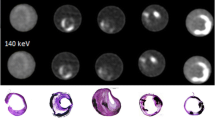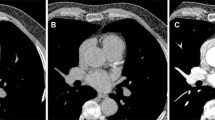Abstract
Cholesterol crystals (CCs) in carotid plaques might be an indicator of vulnerability, although they have not been fully investigated and non-invasive methods of assessment have not been established. This study examines the validity of assessing CCs using dual-energy computed tomography (DECT) that uses X-rays with different tube voltages for imaging, allowing material discrimination. We retrospectively evaluated patients who had undergone preoperative cervical computed tomography angiography and carotid endarterectomy between December 2019 and July 2020. We developed CC-based material decomposition images (MDIs) by scanning CCs crystallized in the laboratory using DECT. We compared the percentage of CCs in stained slides defined by cholesterol clefts with the percentage of CCs displayed by CC-based MDIs. Thirty-seven pathological sections were obtained from 12 patients. Thirty-two sections had CCs; of these, 30 had CCs on CC-based MDIs. CC-based MDIs and pathological specimens showed a strong correlation. Thus, DECT allows the evaluation of CCs in carotid artery plaques.


Similar content being viewed by others
Data availability
The data that support the findings of this study are not publicly available because they contain information that could compromise the privacy of research participants, but are available from the corresponding author (Takuya Saito) upon reasonable request.
Change history
18 March 2023
Missing "Graduate" in author Daisuke Ando's affiliations has been added.
References
Jinnouchi H, Sato Y, Torii S, Sakamoto A, Cornelissen A, Bhoite RR et al (2020) Detection of cholesterol crystals by optical coherence tomography. EuroIntervention 16:395–403. https://doi.org/10.4244/EIJ-D-20-00202
Niyonzima N, Bakke SS, Gregersen I, Holm S, Sandanger Ø, Orrem HL et al (2020) Cholesterol crystals use complement to increase NLRP3 signaling pathways in coronary and carotid atherosclerosis. EBiomedicine 60:102985. https://doi.org/10.1016/j.ebiom.2020.102985
Shi X, Cai H, Wang F, Liu R, Xu X, Li M et al (2020) Cholesterol crystals are associated with carotid plaque vulnerability: An optical coherence tomography study. J Stroke Cerebrovasc Dis 29:104579. https://doi.org/10.1016/j.jstrokecerebrovasdis.2019.104579
Goo HW, Goo JM, Dual-Energy CT, Dual-Energy CT (2017) Dual-Energy CT: New horizon in medical imaging. Korean J Radiol 18:555–569. https://doi.org/10.3348/kjr.2017.18.4.555
Flory CM (1945) Arterial occlusions produced by emboli from eroded aortic atheromatous plaques. Am J Pathol 21:549–565
Machida H, Tanaka I, Fukui R, Shen Y, Ishikawa T, Tate E et al (2016) Dual-energy spectral CT: Various clinical vascular applications. Radiographics 36:1215–1232
Janoudi A, Shamoun FE, Kalavakunta JK, Abela GS (2016) Cholesterol crystal induced arterial inflammation and destabilization of atherosclerotic plaque. Eur Heart J 37:1959–1967. https://doi.org/10.1093/eurheartj/ehv653
Saba L, Saam T, Jäger HR, Yuan C, Hatsukami TS, Saloner D et al (2019) Imaging biomarkers of vulnerable carotid plaques for stroke risk prediction and their potential clinical implications. Lancet Neurol 18:559–572. https://doi.org/10.1016/S1474-4422(19)30035-3
Yang CB, Zhang S, Jia YJ, Duan HF, Ma GM, Zhang XR et al (2017) Clinical application of dual-energy spectral computed tomography in detecting cholesterol gallstones from surrounding bile. Acad Radiol 24:478–482. https://doi.org/10.1016/j.acra.2016.10.006
Funding
This study was supported by the Japanese Society of Cerebral Blood Flow and Metabolism as an approved study in 2021.
Author information
Authors and Affiliations
Corresponding author
Ethics declarations
Conflict of interest
Yukako Yazawa received honoraria to deliver lectures from Bayer, Bristol-Myers Squibb, Daiichi-Sankyo, Stryker, and Medtronic. Takuya Saito, Hidenori Endo, Daisuke Ando, Itsuki Miyagi, Yuichi Kawabata, Mika Watanabe, Atsushi Saito, and Miki Fujimura have reported no disclosures.
Ethical approval
The study protocol was reviewed and approved by the Ethics Committee of the Kohnan Hospital (approval number 2021–0113-01).
Informed consent
Informed consent was waived because of the retrospective nature of the study, and the opt-out method was offered.
Additional information
Publisher's note
Springer Nature remains neutral with regard to jurisdictional claims in published maps and institutional affiliations.
Supplementary Information
Below is the link to the electronic supplementary material.
Rights and permissions
Springer Nature or its licensor (e.g. a society or other partner) holds exclusive rights to this article under a publishing agreement with the author(s) or other rightsholder(s); author self-archiving of the accepted manuscript version of this article is solely governed by the terms of such publishing agreement and applicable law.
About this article
Cite this article
Saito, T., Endo, H., Ando, D. et al. Evaluation of cholesterol crystals in carotid plaque by dual energy computed tomography. Neuroradiology 65, 979–982 (2023). https://doi.org/10.1007/s00234-023-03138-5
Received:
Accepted:
Published:
Issue Date:
DOI: https://doi.org/10.1007/s00234-023-03138-5




